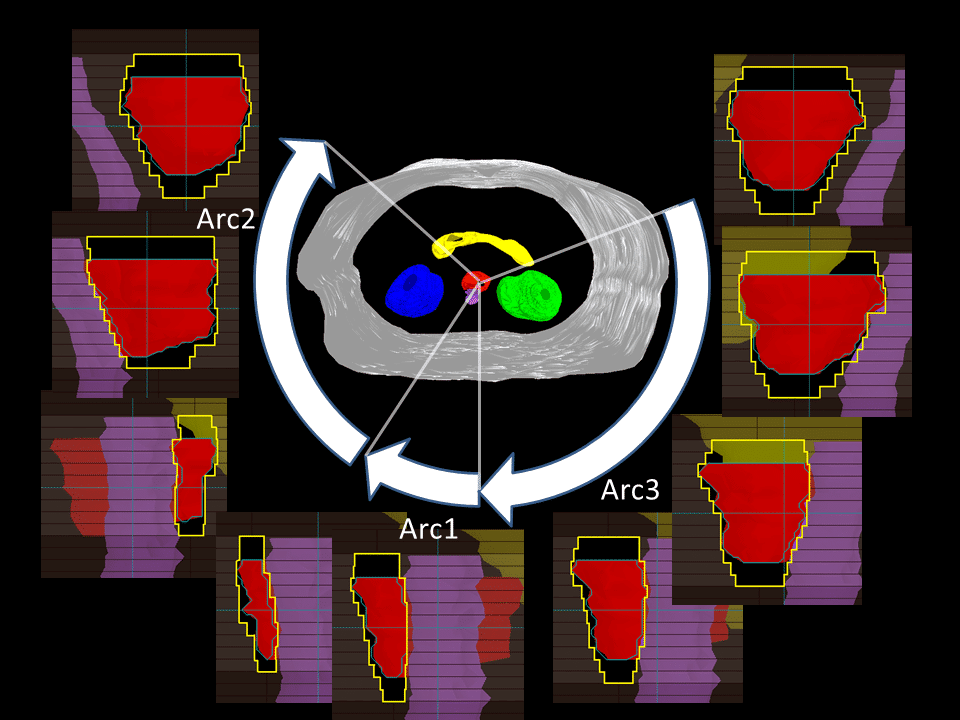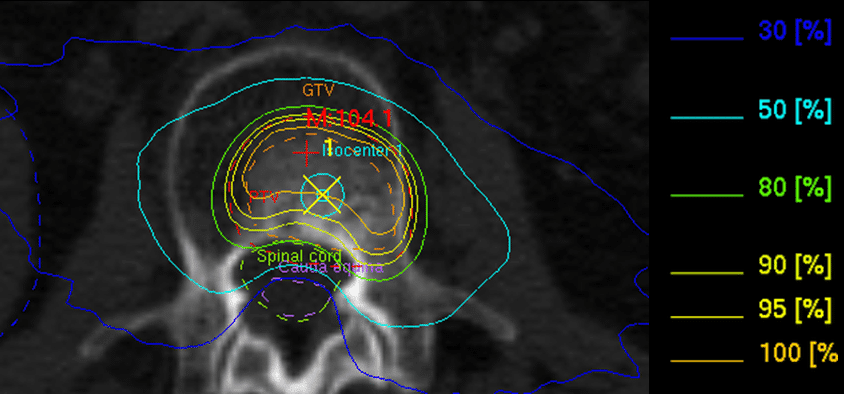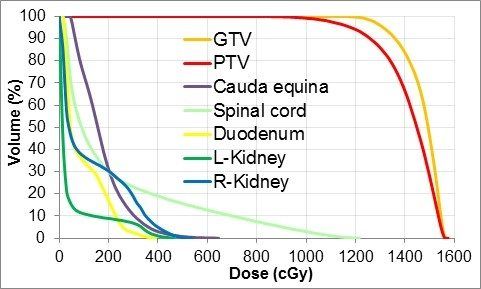LETTER
Shiro Nishiyama1,*, Kiyoshi Yoda2, Tetsuya Komatsu3
1Department of Radiation Oncology, Kuki General Hospital, 418-1 Kamihayami, Kuki, Saitama 346-8530, Japan
2Elekta KK, Research Physics, 3-9-1 Shibaura, Minato-ku, Tokyo, 108-0023, Japan
3Department of Radiation Oncology, Tokai University Hospital, 143 Shimokasuya, Isehara, Kanagawa 259-1193, Japan
Abstract
Reirradiation of spinal metastases requires full consideration of previously delivered dose to the spinal cord thereby significantly constraining further dose delivery. The reirradiation of spinal metastases was frequently performed by Cyberknife or Tomotherapy [1,2]. However, Cyberknife needs longer treatment time, possibly leading to a higher mental or physical burden to the patients with firm immobilization on the treatment couch, whereas Tomotherapy delivers rotational beams from all angles that may increase mean doses in organs at risk (OARs). Meanwhile, stereotactic body radiotherapy was also successfully employed for the reirradiation that allowed high dose to the target while sparing spinal cord and neighbouring OARs [3,4].
Introduction
In our hospital, an add-on micro multileaf-collimator (mMLC), APEX (Elekta, Stockholm, Sweden), was available with a linear accelerator, Synergy (Elekta, Stockholm, Sweden). The leaf width was 2.5 mm on the isocentre plane, and the number of leaf pairs was 56, thereby creating a maximum field size of 14 x 12 cm2. The penumbra width was 2 to 3 mm for 6 or 10 MV resulting in very steep dose gradients, whereas the maximum leaf leakage was approximately 0.75%. The motivation of this planning study was that the above small penumbra width and low leaf leakage would facilitate a highly conformal dose to a target tumour and at the same time lowest possible dose to OARs, which was desirable for the reirradiation of spinal metastases. To our knowledge, the use of the APEX mMLC for the reirradiation of spinal metastases has not been reported.
The purpose of this study was, therefore, to investigate dosimetric usefulness of the APEX mMLC for the reirradiation of spinal metastases. A three partial-arc conformal avoidance plan was created and optimized by manually changing beam weights and leaf positions with a significant effort in minimizing dose to spinal cord and cauda equina.
The patient for this planning study was newly diagnosed with spinal metastases from pancreatic cancer, and conventional radiotherapy was administered to the eighth thoracic vertebrae to the second lumbar vertebra with a total dose of 24 Gy in six fractions. Eleven months later, tumour regrowth was observed in the second lumbar vertebra by magnetic resonance imaging (MRI).
Considering a dose of 24 Gy already delivered to the vertebrae before, a dynamic-arc conformal avoidance plan was created to spare spinal cord (or more precisely, cauda equina) using the mMLC, APEX. Free-breathing CT images were acquired for treatment planning using a four-row multi-detector helical CT, Aquilion TSX-101A (Toshiba, Tochigi, Japan), with a slice thickness of 2 mm.
The delineation of tumour and OARs was performed using a treatment planning system (TPS), XiO ver.4.8 (Elekta, Stockholm, Sweden). The gross tumour volume (GTV) was defined by referring to MRI, and the planning target volume (PTV) was further defined by adding a uniform margin of 3 mm perpendicular to the GTV surface. Kidneys, spinal cord, cauda equina, and duodenum were contoured as OARs.
The structures were transferred to another TPS, Ergo++ ver.1.7.5 (Elekta, Stockholm, Sweden) to create the conformal avoidance plan with a photon energy of 10 MV. The isocentre was defined at the centre of the PTV, and a total dose of 12 Gy was prescribed in four fractions to the 80% isodose line, where the total dose was determined by considering previously delivered dose to the spinal cord. As was mentioned, the spinal cord had already received 24 Gy in 4 Gy fractions. Assuming that a/b for late spinal cord toxicity is 2 Gy [4], a dose of 36 Gy in 2 Gy fractions results in the same biologically effective dose (BED) as above.
Because the tolerable dose for spinal cord is 50 Gy [5] in 2 Gy fractions, a further dose of 14 Gy in 2 Gy fractions may be delivered, which is nearly equivalent to 12 Gy in 4 fractions. In the present study, spinal cord recovery from previous radiotherapy [6] was not taken into account.
Figure 1 shows beam’s eye views for the conformal avoidance plan comprising three partial-arcs created by ERGO ++. Field shapes are depicted as yellow closed lines with the add-on mMLC leaves overlaid. The colours of the organs are as follows: PTV, red; cauda equina, violet; duodenum, yellow; right kidney, blue; left kidney, green. Arc1, Arc2, and Arc3 range from 180 to 210, from 210 to 310, and from 80 to 180 degrees, respectively.

Figure 1. Beam’s eye views for the conformal avoidance plan comprising three partial arcs created by an ERGO ++ treatment planning system. Field shapes are depicted as yellow closed lines with the add-on mMLC leaves overlaid. The colours of the organs are as follows: PTV, red; cauda equina, violet; duodenum, yellow, right kidney, blue; left kidney, green. The gantry angles of Arc1, Arc2, and Arc3 range from 180 to 210, from 210 to 310, and from 80 to 180 degrees, respectively.
Figure 2 shows dose distribution on an isocentric axial plane by the three partial-arc conformal avoidance plan with optimized beam weights and the add-on mMLC. Three beam weights were manually optimized so that the spinal cord (dashed green) lies outside the 80% isodose line where a dose of 12 Gy was prescribed.

Figure 2. Dose distribution on an isocentric axial plane by the three partial-arc conformal avoidance plan with optimized beam weights and the add-on mMLC. Three beam weights were manually optimized so that 80% isodose line (solid green) covered the GTV (dashed orange) and nearly covered the PTV (dashed red), whereas the spine (dashed green) was outside the 80% isodose line and the cauda equina (dashed purple) was outside the 30% isodose line (solid blue).
Figure 3 shows dose volume histogram of the optimized three partial-arc conformal avoidance plan, where 94.2% of the PTV (red) and 99.8% of the GTV (orange) is covered by the prescribed dose of 12 Gy. The maximum doses to the spinal cord (light green), the cauda equina (purple), the duodenum (yellow), the left kidney (green), and the right kidney (blue) are 12.1 Gy, 6.5 Gy, 3.9 Gy, 4.7 Gy, and 5.4 Gy, respectively.

Figure 3. Dose-volume histogram of the optimized three partial-arc conformal avoidance plan, where 94.2% of the PTV (red) and 99.8% of the GTV (orange) is covered by the prescribed dose of 12 Gy. The maximum doses to the spinal cord (light green), the cauda equina (purple), the duodenum (yellow), the left kidney (green), and the right kidney (blue) are 12.1 Gy, 6.5 Gy, 3.9 Gy, 4.7 Gy and 5.4 Gy, respectively.
Radiotherapy for the spinal metastases is performed with a palliative intent and the need of reirradiation to the same spinal region is sometimes experienced. This treatment facilitates reduction of pain, conservation of neural functions, and prevention of pathological fracture. The three partial-arc plan using the add-on mMLC resulted that the maximum doses to the spinal cord and the cauda equine was 12.1 Gy and 6.5 Gy.
We considered that this is owing to a combined impact of a small leaf width of 2.5 mm, a small penumbra of 2 to 3 mm due to double-focus design, and a low leaf leakage of 0.75%. The limitation of this planning study is that the only one case is shown. Further study is required after accumulating more patient data.
In conclusion, we have shown that a dynamic-arc conformal avoidance plan for reirradiation of spinal metastases fulfilled the dose constraint on DVH using an add-on double-focus mMLC. The three partial-arc plan using the add-on mMLC resulted intolerable maximum doses of 12.1 Gy and 6.5 Gy for the spinal cord and the cauda equina, respectively.
Conflict of interest
Kiyoshi Yoda is a full-time employee of Elekta KK, Japan.
References
- Bondiau PY, Doyen J, Mammar H, et al. Reirradiation of spine and lung tumour with CyberKnife. Cancer Radiother. 2010; 14: 438-441.[Reference Source] [PubMed Abstract]
- Sterzing F, Hauswald H, Uhl M, et al. Spinal cord sparing reirradiation with helical tomotherapy. Cancer. 2010; 116: 3961-3968. [CrossRef] [PubMed Abstract]
- Masucci GL, Yu E, Ma L, Chang EL, et al. Stereotactic body radiotherapy is an effective treatment in reirradiating spinal metastases: current status and practical considerations for safe practice. Expert Rev Anticancer Ther. 2011; 11: 1923-1933.[CrossRef] [PubMed Abstract]
- Sahgal A, Ma L, Weinberg V, et al. Reirradiation human spinal cord tolerance for stereotactic body radiotherapy. Int J Radiat Oncol Biol Phys. 2012; 82: 107-116.[CrossRef] [PubMed Abstract]
- Emami B, Lyman J, Brown A, et al. Tolerance of normal tissue to therapeutic irradiation. Int J Radiat Oncol Biol Phys. 1991; 21: 109-122.[CrossRef] [PubMed Abstract]
- Mantel F, Flentje M, Guckenberger M. Stereotactic body radiation therapy in the re-irradiation situation – a review. Radiat Oncol. 2013; 8: 7.[CrossRef] [PubMed Abstract]
Article information
Corresponding Author: Shiro Nishiyama.
Copyright: © 2015 Nishiyama S et al. This is an open-access article distributed under the terms of the Creative Commons Attribution License, which permits unrestricted use, distribution, and reproduction in any medium, provided the original author and source are cited.
How to cite: Nishiyama S, Yoda K, Komatsu T. Reirradiation of spinal metastases using an add-on double-focus micro multileaf collimator and a three partial-arc conformal avoidance technique with optimized beam weights: a planning study. J. Diagn. Imaging Ther. 2015; 2(2): 35-40 (https://dx.doi.org/10.17229/jdit.2015-0508-017).
Article history: Received 24 April 2015; Revised 07 May 2015; Accepted 07 May 2015; Published online 8 May 2015.
Archive link: JDIT-2015-0508-017

You are here: home »
